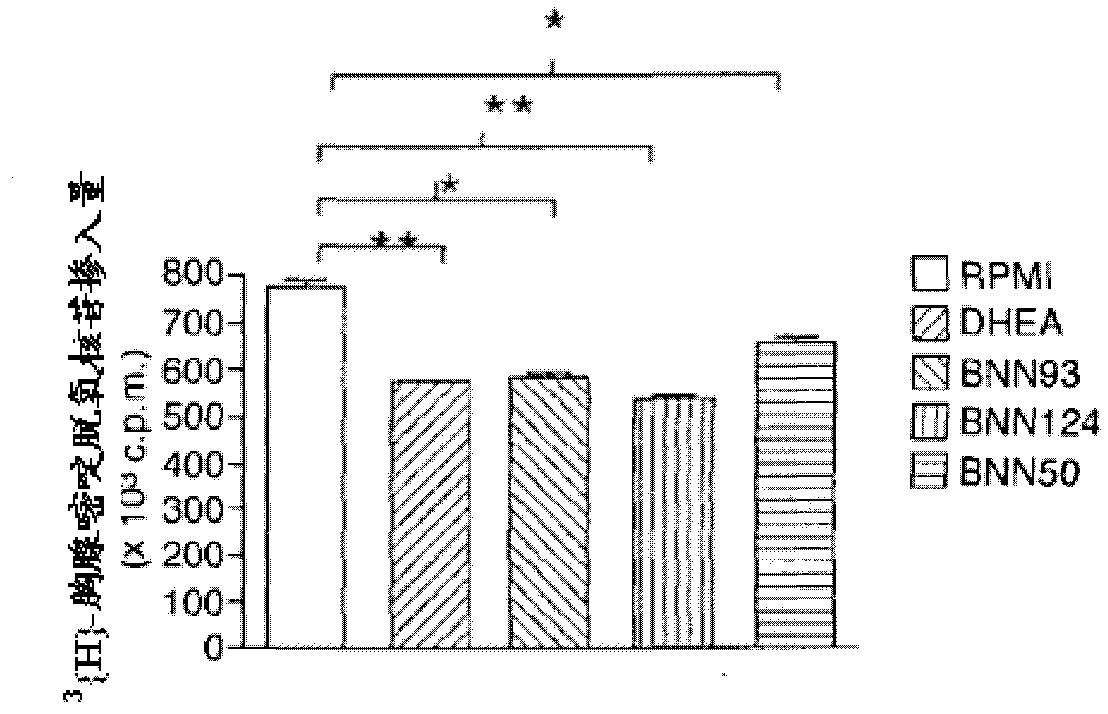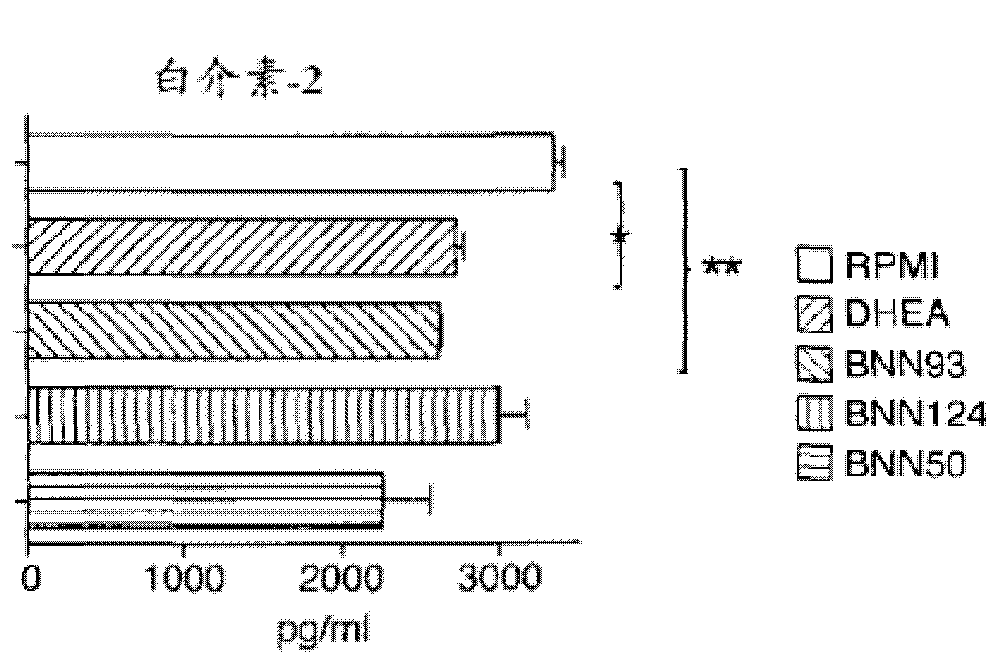Use of steroid compounds for inflammatory and autoimmune disorders
A technology for autoimmune diseases and compounds, applied in the field of application of steroids in inflammatory and autoimmune diseases, can solve problems such as limiting clinical application
- Summary
- Abstract
- Description
- Claims
- Application Information
AI Technical Summary
Problems solved by technology
Method used
Image
Examples
Embodiment 1
[0131] Synthetic Spirosteroid Inhibits T Cell Response Activity in Vitro
[0132] Lymph node (LN) cells were cultured from DO11.10T cell receptor transgenic (DO11.10TCR Tg) mice that were not exposed to antigen (which responded to OVA peptide 323-329), in DHEA or the spiro compound BNN-50, BNN- 93 and BNN-124 or control RPMI were stimulated with OVA. Treatment with DHEA and spiro-analogues resulted in a significant reduction in the proliferation of T cells responding to the antigen ( figure 1 ).
[0133] In order to determine whether DHEA and its analogs are effective on CD4 + T cells exert their immunosuppressive effect directly, and pure T cells were cultured from unexposureed DO11.10 T cell receptor transgenic (DO11.10TCR Tg) mice with mitomycin C-treated splenocytes and OVA peptide 323-329. CD4 + T cells. Furthermore, treatment with DHEA and spiro compounds resulted in a marked reduction in the secretion and proliferation of interleukin-2 and gamma-interferon (Fig. 2)...
Embodiment 2
[0136] Ability of synthetic steroids to protect against MOG peptide-induced experimental autoimmune encephalomyelitis (EAE).
[0137] To evaluate the immunosuppressive effects of DHEA and spiro compounds in vitro, a study was conducted to determine whether DHEA and its spiro analogs could protect against experimental autoimmune encephalomyelitis (EAE). EAE is an autoimmune state of the central nervous system (CNS), caused by infiltration of the central nervous system by destroyed autoreactive T lymphocytes and subsequent demyelination and axonal and neuronal degeneration.
[0138] Acute EAE was induced in C57BL / 6 mice by immunizing mice with pathogenic sphingomyelin oligodendrocyte glycoprotein (MOG) peptide (amino acids 35-55). From the day of EAE induction until the mice were euthanized on day 26, BNN-93, BNN-124, BNN-50 or DHEA (2 mg / mouse) or PBS (control) were administered intraperitoneally every day ( Figure 5 ). Routine care of mice was blinded to clinical signs (par...
Embodiment 3
[0146] Activity of synthetic steroids in suppressing TH-2 immune responses and preventing allergic airway inflammation.
[0147] Using an established mouse model of allergic asthma, the in vivo effects of DHEA and spiro compounds were investigated during TH-2-mediated immune responses and subsequent disease development. BALB / c mice were sensitized by intraperitoneal administration of 0.01 mg chicken ovalbumin (OVA) in 0.2 ml alum on days 0 and 12, and exposed to aerosolized OVA on days 18-20 (5 %20min). On days 0, 1, 2, 12, 13, 14, 18, 19 and 20., mice were given 2 mg / mouse of DHEA or spiro compound (BNN-93 or BNN-124 or BNN-50) or PBS.
[0148] In bronchoalveolar lavage (BAL) of mice treated with DHEA or spiro compounds, the numbers of eosinophils and lymphomonocytes were significantly reduced compared with PBS-treated mice ( Figure 14a ). Leukocyte infiltration in the lungs of mice treated with DHEA and spiro compounds was also significantly reduced ( Figure 14b ). Fu...
PUM
 Login to View More
Login to View More Abstract
Description
Claims
Application Information
 Login to View More
Login to View More - R&D
- Intellectual Property
- Life Sciences
- Materials
- Tech Scout
- Unparalleled Data Quality
- Higher Quality Content
- 60% Fewer Hallucinations
Browse by: Latest US Patents, China's latest patents, Technical Efficacy Thesaurus, Application Domain, Technology Topic, Popular Technical Reports.
© 2025 PatSnap. All rights reserved.Legal|Privacy policy|Modern Slavery Act Transparency Statement|Sitemap|About US| Contact US: help@patsnap.com



